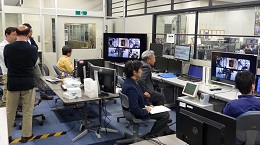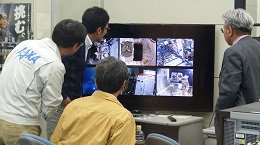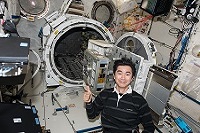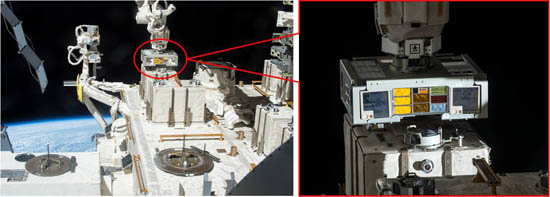This is an archive of information released in the past.
Disclaimer: It may contain broken links or outdated information. Some parts may not function in current web browsers.
*Visit https://humans-in-space.jaxa.jp/en/ for the latest information.

Experiment
- News
- Kibo Utilization Strategy
- Kibo Utilization Plan
- List of JAXA's Utilization Themes
- Experiment Facilities
- Space Environment Utilization
- Archive
The second experiment using the ExHAM now underway
JAXA's Exposed Experiment Handrail Attachment Mechanism (ExHAM) provides an easy way to conduct material tests in an extreme space environment for the use of future artificial satellites and spacecraft, in order to clarify the following:
- To see how materials or parts actually change in space.
- To see how materials or parts degrade over a period of time.
- To search what kinds of particles are floating in space.
The ExHAM offers the advantage of being able to return samples directly to the cabin after exposure to the space environment, without the need to perform Extravehicular Activities.
Following the first experiment in May 2015, this marks the second experiment using the ExHAM. The following test samples were attached to the ExHAM2.
- Space Environment Exposure Tests of Functional Thin Film Devices for Future Solar Sail Mission (Solar Sail)
- Space Environmental Testing of Lightweight and High-Precision Carbon Composite Mirrors (CFRP Mirror)
- Astrobiology Exposure and Micrometeoroid Capture Experiments (TANPOPO)
- Space Environment Exposure Experiment of Carbon Nanotube Material for Space Application (CNT)
- Space Environmental Testing of PEEK and PFA sample (PEEK)
Among the above, samples of the Solar Sail and CFRP Mirror were reproduced in a short time, despite both being lost at launch failure of the Cygnus spacecraft (Orb-3). The ExHAM2 hardware was carried aboard KOUNOTORI5 (HTV5); the Dragon spacecraft (SpX-6) and KOUNOTORI5 delivered the samples in April and August 2015, respectively.
On October 30, Astronaut Kimiya Yui attached the samples to surfaces of the ExHAM2. Then during the evening to night on November 11, the ExHAM2 was pushed out to the Kibo's EF, captured and transferred by Kibo's robotic arm (Japanese Experiment Module Remote Manipulator System: JEMRMS), and then attached to the handrail on the EF.


The researchers and other personnel concerned monitoring the ExHAM2 attachment operations (Credit: JAXA)
*All times are Japan Standard Time (JST)
| Copyright 2007 Japan Aerospace Exploration Agency | Site Policy |

